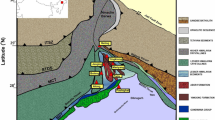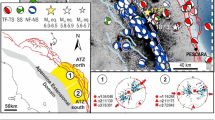Abstract
In West Bohemia in the period of 2003–2005 five permanent GPS stations were established to detect local movement trends. Their mutual position changes were determined from time series of GPS observations and were associated with seismic, gravity, and geo-scientific data related to the geodynamics of the West Bohemian region. Knowledge of local physical processes based on spatial and time earthquake occurrences, focal mechanisms of main events, stress and strain fields set up a tool for recent seismotectonic analyses. The permanent GPS measurements bring independent effective phenomenon, direct monitoring of site movements. The movements detected by our GPS stations evidenced WSW-ENE extension with subsiding trends in the western part of the Cheb Basin and the Smrčiny Mts. Besides, there were monitored dextral movements along the Mariánské Lázně tectonic fault zone (MLF). A comparison of results with previous data formed a presumption that an antithetic stress pattern has to exist inside the inner part of the MLF tectonic zone. This antithetic stress can explain the coexistence of dextral and sinistral movements on individual tectonic elements in the West Bohemian area.
Similar content being viewed by others
References
Antonini M., 1988. Variations in the focal mechanism during the 1985/86 Western Bohemian earthquake swarm sequence-correlation with spatial distribution of foci and suggested geometry of faulting. In: Procházková D. (Ed.), Induced Seismicity and Associated Phenomena. Geophys. Inst. Czechosl. Acad. Sci., Praha, 250–270.
Bankwitz P., Schneider G., Kämpf H. and Bankwitz E., 2003. Structural characteristics of epicentral areas in Central Europe: study case Cheb Basin (Czech Republic). J. Geodyn., 35, 5–32.
Behm M., Brückl E., Mitterbauer U., CELEBRATION 2000 and ALP 2002 Working Groups, 2007. A new seismic model of the Eastern Alps and its relevance for geodesy and geodynamics. Vermessung & Geoinformation, 2, 121–133.
Calais E., Nocquet J.-M., Jouanne F. and Tardy M., 2002. Currents strain regime in the Western Alps from continuous GPS measurements, 1996–2001. Geology, 30, 651–654.
Collombet M., Thomas J.C., Chauvin A., Tricart P., Bouillin J.P. and Gratier J.P., 2002. Counterclockwise rotation of the Western Alps since the Oligocene: New insights from paleomagnetic data. Tectonics, 21, 1032, doi: 10.1029/2001TC901016.
Čermák V., Šafanda J., Krešl M. and Kučerová L., 1996. Heat flow studies in Central Europe with special emphasis on data from former Czechoslovakia. Global Tect. Metallogeny, 5(3/4), 109–123.
Estey L.H. and Meertens C.M., 1999. TEQC: The multi-purpose toolkit for GPS/GLONASS data. GPS Solutions, 3(1), 42–49.
Finger F., Gerdes A., Janoušek V., René M. and Riegler G., 2007. Resolving the Variscan evolution of the Moldanubian sector of the Bohemian Massif: the significance of the Bavarian and the Moravo-Moldanubian tectonometamorphic phases. J. Geosci., 52, 9–28.
Grácová M., Mantlík F., Schenk V. and Schenková Z., 2007. Data processing of GNSS observations of the GEONAS network-effects of extreme meteorological conditions. Acta Geodyn. Geomater., 4(4), 153–161.
Grünthal G., Schenk V., Zeman A. and Schenková Z., 1990. Seismotectonic model for the earthquake swarm 1985/86 in the Vogtland/West Bohemia focal area. Tectonophysics, 174, 369–383.
Hainzl S. and Fischer T., 2002. Indications for a successively triggered rupture growth underlying the 2000 earthquake swarm in Vogtland/NW Bohemia. J. Geophys. Res., 107(B12), 2338, doi: 10.1029/2002JB001865.
Heinicke J. and Koch U, 2000. Slug flow-a possible explanation for hydrogeochemical earthquake precursors at Bad Brandbach, Germany. Pure Appl. Geophys., 157, 1621–1641.
Heuer B., 2006. Lithospheric and Upper Mantle Structure beneath the Western Bohemian Massif Obtained from Teleseismic P and S Receiver Functions. PhD Thesis, GFZ Scientific Technical Report STR06/12, GeoForschung Zentrum, Potsdam, Germany, 149 pp.
Heuer B., Geissler W.H., Kind R. and Kämpf H., 2006. Seismic evidence for asthenospheric updoming beneath the western Bohemian Massif, central Europe. Geophys. Res. Lett., 33, L05311, doi: 10.1029/2005GL025158.
Horálek J., Fischer T., Boušková A. and Jedlička, P., 2000. Western Bohemia/Vogtland region in the light of the WEBNET network. Stud. Geophys. Geod., 44, 107–125.
Horálek J., Šíleny J. and Fischer T., 2002. Moment tensors of the January 1997 earthquake swarm in NW Bohemia (Czech Republic): double-couple vs. non-double-couple events. Tectonophysics, 356, 65–85.
Hugentobler U., Dach R., Fridez P. and Meindl M. (Eds.), 2005. Bernese GPS Software-Version 5.0. Astronom. Inst., University of Bern, Bern, Switzerland, 464 pp.
Kaiser A., Reicherter K., Hübscher C. and Gajewski, D., 2005. Variation of the present-day stress field within the North German Basin-insights from thin shell FE modeling based on residual GPS velocities. Tectonophysics, 397, 55–72.
Kárník V., Schenk V. and Schenková Z., 1987. Earthquake swarm in Western Bohemia 1985/1986: Some characteristics. Ann. Geophys., 5B(6), 691–700.
Kostelecký J. and Vondrák J., 2003. IERS and its importance for global geodynamics. Acta Montana IRSM AS CR, Series A, 24(131), 7–19.
Kottnauer P., Rucky A., Schenk V. and Schenková Z., 2003. Note to remote control of GPS observatory using GSM modem. Acta Montana, Series A, 24(131), 163–165.
Larson K.M., Freymueller J.T. and Philipsen S., 1997. Global plate velocities from the global positioning system. J. Geophys. Res., 102(B5), 9961–9981.
Mantlík F., Kottnauer P., Schenk V. and Schenková Z., 2005. Transmission of continuously recorded data from remote GPS permanent stations to IRSM central unit. Acta Geodyn. Geomater., 2(3), 69–73.
Mrlina J., 1997. Temporal variations of gravity in Western Bohemia: period 1993–1996. Stud. Geophys. Geod., 41, 307–318.
Mrlina J., 2000. Vertical displacements in the Nový Kostel seismoactive area. Stud. Geophys. Geod., 44, 336–345.
Mrlina J., Špičák A. and Skalský L., 2003. Non-seismological indications of recent tectonic activity in the West Bohemia earthquake swarm region. J. Geodyn., 35, 221–234.
Schenk V., Kottnauer P., Schenková Z. and Hájek P., 2004. Czech permanent GPS observatories for geodynamic investigations of the Bohemian Massif operated by the Institute of Rock Structure and Mechanics, Prague. Acta Geodyn. Geomater., 1(3), 111–114.
Schenk V., Jechumtálová Z. and Schenková Z., 2007. Post-seismic slip of the February 2004 earthquake swarm detected by GPS in West Bohemia, Central Europe. Eos Trans. AGU, 88(52), Fall Meet. Suppl., Abstract G13A-0925.
Špičák A., Mrlina J., Jindra D. and Mervart L., 1997. Repeated geodetic measurements in the West Bohemia seismoactive region: period 1993–1996. Stud. Geophys. Geod., 41, 319–328.
Špičák A., Mrlina J., Jindra D. and Mervart L., 1999. Monitoring of geodynamic activity in the West Bohemia seismoactive region between 1993–1996. J. Geodyn., 27, 119–132.
Švancara J., Gnojek I., Hubatka F. and Dědáček K., 2000. Geophysical field pattern in the West Bohemian geodynamic active area. Stud. Geophys. Geod., 44, 307–326.
Twiss R.J. and Moores E.M., 1992. Structural Geology, 2nd Edition. W. H. Freeman, New York, 736 pp.
Wagner G.A., Gögen K., Jonckheere R., Wagner I. and Woda C., 2002. Dating of the Quaternary volcanoes Komorní Hůrka (Kammerbühl) and Železná Hůrka (Eisenbühl), Czech Republic, by TL, ESR, alpha-recoil and fission track chronometry. Z. Geol. Wiss., 30, 191–200.
Weise S., Brauer, K., Kämpf H., Strauch G. and Koch U., 2001. Transport of mantle volatiles through the crust tracen by seismically released fluids: a natural experiment in the earthquake swarm area Vogtland/NW Bohemia, Central Europe. Tectonophysics, 336, 137–150.
Wendt J. and Dietrich R., 2003. Determination of recent crustal deformations based on precise GPS measurements in the Vogtland earthquake area. J. Geodyn., 35, 235–246.
Wirth W., Plenefisch T., Klinge K., Stammler K. and Seidl D., 2000. Focal mechanisms and stress field in the region Vogtland/Western Bohemia. Stud. Geophys. Geod., 44, 126–141.
Author information
Authors and Affiliations
Corresponding author
Rights and permissions
About this article
Cite this article
Schenk, V., Schenkova, Z. & Jechumtálová, Z. Geodynamic pattern of the West Bohemia region based on permanent GPS measurements. Stud Geophys Geod 53, 329–341 (2009). https://doi.org/10.1007/s11200-009-0021-y
Received:
Revised:
Accepted:
Published:
Issue Date:
DOI: https://doi.org/10.1007/s11200-009-0021-y




